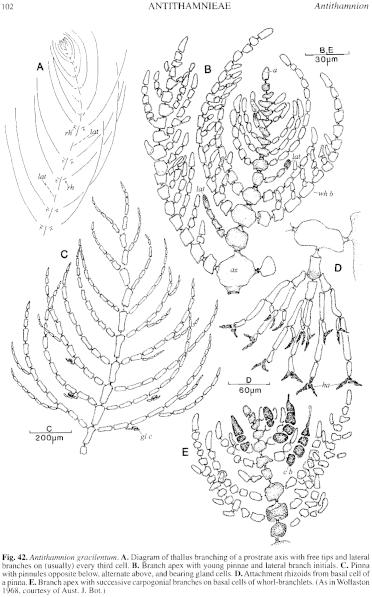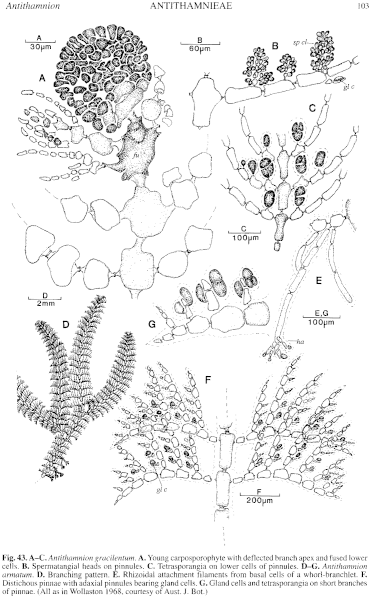|
|
|
|
|
|||||||||||
|
Electronic Flora of South Australia Species Fact Sheet
Phylum Rhodophyta – Order Ceramiales – Family Ceramiaceae – Tribe Antithamnieae
Selected citations: Agardh 1896, index p. 1). Athanasiadis 1996: 156. De Toni 1903: 1406. Huisman & Walker 1990: 418. Lucas 1909: 51. Millar & Kraft 1993: 35. Silva et al. 1996: 378. Wollaston 1968: 284, figs 16, 17A–G.
Synonym
Callithamnion gracilentum Harvey 1855a: 560; 1863, synop.: liv. J. Agardh 1876: 21. Sonder 1881: 11. Tisdall 1898: 502. Wilson 1892: 187.
Thallus (Fig. 42A) medium to dark red-brown, with branched prostrate axes bearing erect, opposite, distichous pinnae to 5 mm high, not entirely complanately branched, pinnae (Fig. 41B, C) with 3–8 lower pairs of opposite lax, often diverging pinnules, alternate above. Attachment by branched multicellular processes (Fig. 42D) with terminal haptera, arising from cells of prostrate axes; epiphytic (on Cystophora spp.). Structure. Apical cells 7–9 µm in diameter and L/D 1–2, increasing to 130–180 µm in diameter and L/D 1–2 (–3) in mature axial cells. Pinnae (Fig. 42B, C) with a small isodiametric basal cell, cells of rachis 35–80 µm in diameter and L/D 1.5–2.5, decreasing in pinnules to 20–40 µm in diameter and L/D 1–2 several cells below their ends; gland cells (Fig. 42C) on special 2–4-celled branches on the lower sides of pinnule cells, 2–4 cells from pinnule base. Lateral branches arising regularly and alternately usually at intervals of 3 (–4) axial cells, directly from the axial cells. Cells uninucleate; rhodoplasts discoid, elongate in larger cells.
Reproduction: Gametophytes dioecious. Procarps (Fig. 42E) with a 4-celled carpogonial branch borne on the basal cell (supporting cell) of successive pinnae. Post-fertilization fusions occur (Fig. 43A) between the axial cell, supporting cell, and foot cell and upper cell from the auxiliary cell, and the upper cell forms the first gonimolobe 400–1000 µm across of carposporangia 40–70 µm in diameter; pinnae on axial cells below the carposporophyte enlarge and curve over the carposporophyte (Fig. 41A). Spermatangial heads (Figs 41B, 43B) occur on special branches on the adaxial side of lower cells of the pinnules, each head 35–55 µm in diameter and L/D 1–2, with an axis of 5–8 cells each bearing a whorl of 4 cells with terminal spermatangia.
Tetrasporangia (Figs 41C, 43C) occur adaxially on basal (to third) cells of pinnules, sessile, ovoid, 45–90 µm in diameter, decussately or cruciately divided.
Type from Rottnest I., W. Aust. (Harvey); holotype in Herb. Harvey, TCD (Tray. Set 327).
Selected specimens: Point Avoid, S. Aust., on Cystophora siliquosa, drift (Womersley, 2.xii.1975; AD, A46921). Sleaford Bay, Port Lincoln, S. Aust., on C. siliquosa, reef edge (Womersley, 20.viii.1967; AD, A31822). Ethel Bay, Yorke Pen., S. Aust., on C. intermedia, upper sublittoral (Wollaston, 28.i.1962; AD, A25506). Aldinga, S. Aust., on C. monilifera, upper sublittoral (Womersley, 29.vii.1966; AD, A30632 "Marine Algae of southern Australia" No. 100). Petrel Cove, Victor Harbor, S. Aust., on C. retorta, in pools (Womersley, 27.ix.1963; AD, A29856). Vivonne Bay, Kangaroo I., S. Aust., on C. subfarcinata, in pool (Womersley, 29.viii.1950; AD, A15440). Pennington Bay, Kangaroo I., S. Aust., on C. intermedia, reef edge (Wollaston, 26.i.1956; AD, A20054). Robe, S. Aust., on C. moniliformis, drift (Womersley, 23.viii.1960; AD, A24461). Bridgewater Bay, Vic., on C. subfarcinata, upper sublittoral (Womersley, 14.iv.1959; AD, A22640). Point Lonsdale, Vic., on Cystophora, 2–4 m deep (Kraft, 31.iii.1963; MELU). Reminie, Tas., on C. retorta, reef pools (Wollaston & Mitchell, 25.ii.1964; AD, A27515).
Distribution: Rottnest I., W. Aust., to Mowarry Point, N.S.W. (Millar & Kraft 1993, p. 35) and W Tasmania.
References:
AGARDH, J.G. (1876). Species Genera et Ordines Algarum. Vol. 3, Part 1- Epicrisis systematic Floridearum, pp. i-vii, 1–724. (Weigel: Leipzig.)
AGARDH, J.G. (1892). Analecta Algologica. Acta Univ. lund. 28, 1–182, Plates 1–3.
AGARDH, J.G. (1896). Analecta Algologica. Cont. III. Acta Univ. lund. 32, 1–140, Plate 1.
ATHANASIADIS, A. (1996). Morphology and classification of the Ceramioideae (Rhodophyta) based on phylogenetic principles. Opera Botanica No. 128, pp. 1–216.
DE TONI, G.B. (1903). Sylloge Algarum omnium hucusque Cognitarum. Vol. 4. Florideae. Sect. 3, pp. 775–1521 + 1523–1525. (Padua.)
HARVEY, W.H. (1855a). Some account of the marine botany of the colony of Western Australia. Trans. R. Jr. Acad. 22, 525–566.
HARVEY, W.H. (1863). Phycologia Australica. Vol. 5, Plates 241–300, synop., pp. i-lxxiii. (Reeve: London.)
HUISMAN, J.M. & WALKER, D.I. (1990). A catalogue of the marine plants of Rottnest Island, Western Australia, with notes on their distribution and biogeography. Kingia 1, 349–459.
LUCAS, A.H.S. (1909). Revised list of the Fucoideae and Florideae of Australia. Proc. Linn. Soc. N.S.W. 34, 9–60.
MILLAR, A.J.K. & KRAFT, G.T. (1993). Catalogue of marine and freshwater Red Algae (Rhodophyta) of New South Wales, including Lord Howe Island, South-western Pacific. Aust. Syst. Bot. 6, 1–90.
SILVA, P.C., BASSON, P.W. & MOE, R.L. (1996). Catalogue of the Benthic Marine Algae of the Indian Ocean. (University of California Press: Berkeley, Los Angeles & London.)
SONDER, O.W. (1881). In Mueller, F., Fragmenta Phytographiae Australiae. Supplementum ad volumen undecinum: Algae Australianae hactenus cognitae, pp. 1–42, 105–107. (Melbourne.)
TISDALL, H.T. (1898). The algae of Victoria. Rep. 7th Meet. Aust. Ass. Adv. Sci., Sydney, 1898, pp. 493–516.
WILSON, J.B. (1892). Catalogue of algae collected at or near Port Phillip Heads and Western Port. Proc. R. Soc. Vict. 4, 157–190.
WOLLASTON, E.M. (1968).Morphology and taxonomy of southern Australian genera of Crouanieae Schmitz (Ceramiaceae, Rhodophyta). Aust. J. Bot. 16, 217–417.
The Marine Benthic Flora of Southern Australia Part IIIC complete list of references.
Publication:
Womersley, H.B.S. (24 December, 1998)
The Marine Benthic Flora of Southern Australia
Rhodophyta. Part IIIC. Ceramiales – Ceramiaceae, Dasyaceae
©State Herbarium of South Australia, Government of South Australia
Illustrations in Womersley Part IIIA, 1998: FIGS 41 A–C, 42, 43 A–C.

Figure 41 enlarge
Fig. 41. A–C. Antithamnion gracilentum (A, AD, A25506; B, C, AD, A29856). A. Branches with carposporophytes. B. Pinna with spermatangial heads. C. Pinna with tetrasporangia. D–F. Antithamnion armatum (D, AD, A29695; E, AD, A31633; F, AD, A51268). D. Habit. E. Pinnules with spermatangial clusters. F. Pinnae with adaxial pinnules bearing gland cells and tetrasporangia

Figure 42 enlarge
Fig. 42. Antithamnion gracilentum. A. Diagram of thallus branching of a prostrate axis with free tips and lateral branches on (usually) every third cell. B. Branch apex with young pinnae and lateral branch initials. C. Pinna with pinnules opposite below, alternate above, and bearing gland cells. D. Attachment rhizoids from basal cell of a pinna. E. Branch apex with successive carpogonial branches on basal cells of whorl-branchlets. (As in Wollaston 1968, courtesy of Aust. J. Bot.)

Figure 43 enlarge
Fig. 43. A–C. Antithamnion gracilentum. A. Young carposporophyte with deflected branch apex and fused lower cells. B. Spermatangial heads on pinnules. C. Tetrasporangia on lower cells of pinnules. D–G. Antithamnion armatum. D. Branching pattern. E Rhizoidal attachment filaments from basal cells of a whorl-branchlet. F. Distichous pinnae with adaxial pinnules bearing gland cells. G. Gland cells and tetrasporangia on short branches of pinnae. (All as in Wollaston 1968, courtesy of Aust. J. Bot.)

|
Email Contact: State Herbarium of South Australia |

|